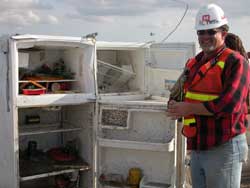Nestled in the valley of Mount Katrina, roughly 20 mucky acres on the eastern end of the recently-reopened, massive Old Gentilly Landfill in eastern New Orleans, lies the white goods processing/staging area. For the uninitiated in debris removal, the white goods waste stream comprises stoves, washers, dryers, household appliances, air conditioning units, hot water heaters and the big stinky‑refrigerators. When a half million New Orleanians evacuated, they left behind refrigerators and freezers full of what people in these parts love to eat–pots of red beans and rice with sausage, gumbo, shrimp, fish, deer meat, alligator sausage and andouille. Mix it all together, seal in an airtight container, turn off the power, add heat and let it fester and ferment for two months, or six. Get the picture? Well, smell may not be easily conveyed in a print medium, but the abundance of maggots, brown goo and respirators (worn by workers) may offer a hint of the pungent aroma that wafted through virtually every neighborhood in the city for the past few months as residents placed their fridges curbside and have come together here in a communal, odiferous meeting of the smells.
 |
| Probyn: “this is like heaven.” |
Here, stoves, air conditioners freezers and refrigerators enjoy merely a brief, sordid interlude on their journey from loving homes to the recycling facility at Southern Scrap. This is where the environmental response team (a joint venture of the U.S. EPA, Coast Guard and Louisiana Dept. of Environmental Quality) extracts Freon from units before they are crushed and sent to a metal recycler. “We have collected a total of 301, 776,” said Cindy Fanning, information officer for the response team. “From that total number, 268, 802 units have had Freon extracted from them.” The refrigerant goes to a recovery contractor for permitted reuse.
Although some view the white goods area as some distorted, post-K version of the Island of Misfit Toys, it is a veritable playground for Al Probyn, site supervisor for the Corps. “For a guy like me, this is like heaven,” said Probyn, who grew up on a farm in Glassford, Ill., and used to seek out stinky, dead things with his brother. “We would flip them over to see what kind of bugs were in them,” he said. “To me, this would be like a kitchen in Korea,” he said, poking his nose inside one maggot-infested fridge. “Kim chee smells worse than this.”
Probyn’s resume includes a stint at a Colorado meatpacking plant.. “I got to work on the little auger that ground up heads. I seem to be attracted to things with maggots.” Probyn, who also worked as a quality assurance inspector for the National Center for Agricultural Utilization and Research, views the white goods detail as not merely appealing to the olfactory senses, but a stimulating social experiment in the human condition.
“You can tell a lot about people by what they eat,” he said. In addition to storing food, refrigerators alternate as glaring billboards and panoramas of people’s lives. Many of the units sport angry post-Katrina messages, many of them profane, spray-painted in vivid colors, as well as photos and magnets with phone numbers of local attorneys and insurance agents. Walking through some areas, one could easily discern which refrigerators were collected from the same block: they all sported the...

Post a comment to this article
Report Abusive Comment